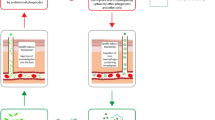Abstract
—Four goats, which had been previously bitten on two different occasions by Glossina morsitans centralis infected with Trypanosoma congolense and subsequently treated on each occasion with the trypanocidal drug diminazene aceturate were each fed upon by six uninfected tsetse. Hypersensitivity reactions developed in the skin of two of the goats within 1 hr after the bite, and reached a maximum intensity over the next 24 hr. In order to determine whether hypersensitive skin reactions could be induced by tsetse saliva alone, six different goats were bitten by uninfected tsetse up to eight times. Only a few small nodular skin reactions were noticed. However, following infection and treatment and another sequence of uninfected tsetse bites, hypersensitive skin reactions did occur in two animals, although the reactions were not as severe as anticipated. The hypersensitivity reactions usually precede but sometimes overlap the chancre reaction elicited by metacyclic trypanosomes transmitted by tsetse.
Résumé
—Quatre chèvres sont préalablement infectées en deux occasions par Glossina morsitans centralis porteuse de Trypanosoma congolense et traitées consécutivement avec un trypanocide, le diminazène acéturate. Chaque chèvre sert ensuite à nourrir 6 mouches tsétsé non infectées. On observe des réactions d’hypersensibilité au niveau cutané sur deux des chèvres dans l’heure qui suit la piqûre. Cette réaction atteint son intensité maximale dans les 24 hr suivantes.
De manière à determiner si cette réaction d’hypersensibilité cutanée est uniquement induite par la salive de la tsétsé, 6 autres chèvres sont piquées jusqu’ à 8 fois de suite par des tsétsé non infectées. Seules quelques petites réactions cutanées nodulaires sont observées. Ces six animaux sont ensuite infectés par des tsétsé porteuses de T. congolense et traitées consécutivement avec le diminazène acéturate. Une autre séquence de piqûres par des tsétsé non infectées est réalisée. Deux animaux développent une réaction d’hypersensibilité cutanée moins sévère que celle observée précédemment. Ces réactions d’hypersensibilité cutanée précèdent habituellement l’apparition du chancre cutané. Elles peuvent parfois se superposer au chancre provoqué par les formes métacycliques de T. congolense injectées par la tsétsé.
Similar content being viewed by others
References
Akol G. W. O. and Murray M. (1983) Trypanosoma congolense: susceptibility of cattle to cyclical challenge. Expl Parasit. 55, 386–393.
Brown S. J. and Cipriano D. M. (1984/85) Introduction of systemic and local basophil and eosinophil responses in guinea pigs by the feeding of the tsetse fly Glossina morsitans. Vet. Parasit. 17, 337–348.
Cook H. C. (1974) Manual of Histological Demonstration Techniques. Butterworth, London.
Emery D. L. and Moloo S. K. (1980) The sequential cellular changes in the local skin reaction produced in goats by Glossina morsitans morsitans infected with Trypanosoma (Trypanozoon) brucei. Acta trop. 37, 137–149.
Emery D. L. and Moloo S. K. (1981) The dynamics of the cellular reactions elicited in the skin of goats by Glossina morsitans morsitans infected with Trypanosoma (Nan-nomonas) congolense or T. (Duttonella) vivax. Acta trop. 38, 15–28.
Gordon R. M. and Crewe W. (1948) The mechanisms by which mosquitoes and tsetse-flies obtain their blood-meal, the histology of the lesions produced and the subsequent reactions of the mammalian host; together with some observations on the feeding of Chrysops and Cimex. Ann. trop. Med. Parasit. 42, 334–356.
Gordon R. M. and Willett K. C. (1958) Studies on the deposition, migration and development to the blood forms of trypanosomes belonging to the Trypanosoma brucei group. III. Ann. trop. Med. Parasit. 52, 346–365.
Gordon R. M., Willett K. C. and Soltys M. A. (1955) The deposition of trypanosomes by the tsetse fly. Trans. R. Soc. trop. Med. Hyg. 49, 5.
Lester H. M. O. and Lloyd L. (1928) Notes on the process of digestion in tsetse-flies. Bull. ent. Res. 19, 39–60.
Luckins A. G., Rae P. F. and Gray A. R. (1983) Infection, immunity and the development of local skin reactions in rabbits infected with cyclically-transmitted stocks of Trypanosoma congolense. Ann. trop. Med. Parasit. 11, 569–582.
Murray M., Murray P. K. and Mclntyre W. I. M. (1977) An improved parasitological technique for the diagnosis of African trypanosomiasis. Trans. R. Soc. trop. Med. Hyg. 71, 325–326.
Nash T. A. M. (1970) Possible induction in goats of immunological tolerance against the saliva of uninfected tsetse flies (Glossina spp.). Trop. Anim. Hlth Prod. 2, 126–130.
Author information
Authors and Affiliations
Rights and permissions
About this article
Cite this article
Dwinger, R.H., Murray, M. & Moloo, S.K. Skin Hypersensitivity to Bites of Glossina Morsitans Centralis in Goats. Int J Trop Insect Sci 7, 653–657 (1986). https://doi.org/10.1017/S1742758400011619
Received:
Revised:
Published:
Issue Date:
DOI: https://doi.org/10.1017/S1742758400011619




